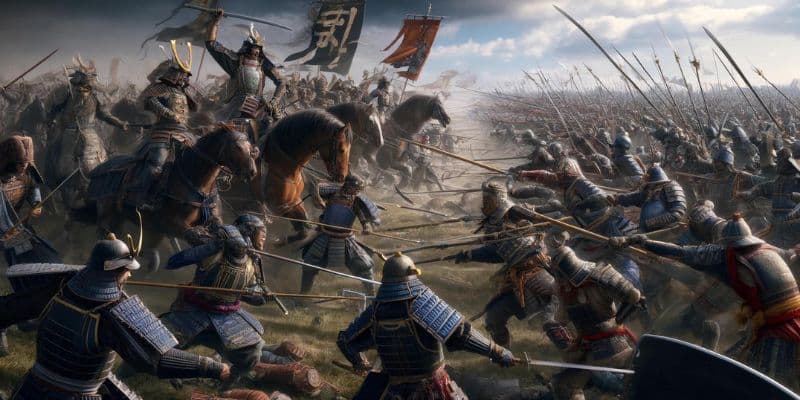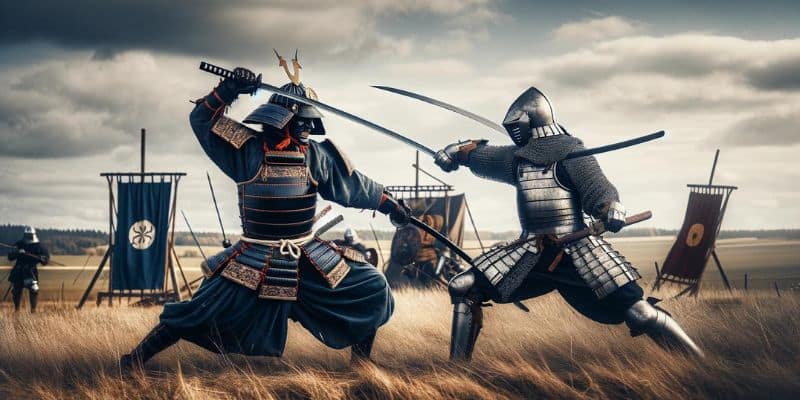Have you ever wondered who would win in a battle between a Japanese Samurai and a Medieval Knight? This question has fascinated many people, sparking countless debates and imaginations. Both the samurai and the knight are iconic warriors from their respective cultures, known for their skill, bravery, and distinctive armor and weapons.
In this article, you’ll explore the fascinating world of these two legendary fighters. By the end, you’ll have a deeper understanding of what made each warrior unique and perhaps even a better idea of who might come out on top in this epic showdown.

Scenario 1: Duel
Strengths and Weaknesses of Both Warriors
Samurai Strengths
Swordsmanship: Samurai were highly skilled in kenjutsu, the art of the sword. Their training with the katana made them incredibly precise and fast in combat. You would see swift, fluid strikes aimed at exploiting any opening.
Agility: Samurai armor, such as Do-Maru, was designed for flexibility and movement. This allowed for quick dodges and rapid changes in position, making it harder for the knight to land a decisive blow.
Archery Skills: If the duel allowed for a ranged start, the samurai’s expertise in archery could provide an early advantage. The yumi (longbow) could strike the knight before close combat ensued.
Samurai Weaknesses
Armor Protection: While more flexible, samurai armor offered less protection compared to knightly plate armor. You might find that the samurai is more vulnerable to strong, direct hits.
Close Quarters Combat: In a duel where the fight quickly becomes close-quarters, the samurai might be at a slight disadvantage due to the knight’s heavier armor and powerful strikes.
Knight Strengths
Heavy Armor: Knights wore plate armor that provided excellent protection against cuts and thrusts. As a knight, you would be well-shielded from the samurai’s strikes, making it harder for them to inflict serious damage.
Powerful Strikes: Trained in the use of the longsword, knights delivered powerful, crushing blows. In close combat, your strikes could potentially overwhelm the samurai’s defenses.
Shield Use: Knights often used shields for additional protection and offense. You could block incoming attacks and create openings for counterattacks, adding an extra layer of defense.
Knight Weaknesses
Mobility: The heavy plate armor, while protective, could limit your mobility. The samurai’s agility might allow them to outmaneuver you, landing strikes in less protected areas.
Stamina: The weight of the armor could lead to quicker fatigue. If the duel extended over a longer period, you might find it challenging to maintain your strength and speed.
Samurai Victory
The samurai’s speed and precision might allow them to outmaneuver the knight, landing critical strikes in less protected areas. Using their katana, the samurai could exploit the knight’s slower movements and heavier armor, leading to a swift and decisive victory.
Factors Influencing the Result
Agility and Speed: Samurai armor, such as Do-Maru, is designed for flexibility and quick movement. As a samurai, you would use your agility to dodge the knight’s powerful strikes and move swiftly around the battlefield. This speed allows you to strike quickly and retreat before the knight can respond effectively.
Precision and Skill: Samurai are known for their exceptional swordsmanship. Your training in kenjutsu, the art of the sword, enables you to deliver precise and deadly strikes. You would aim for the knight’s weak points, such as the joints and gaps in the armor, to inflict maximum damage.
Archery Advantage: If the duel begins at a distance, your skill with the yumi (longbow) could give you an early advantage. Accurate and powerful shots could weaken the knight before they close in for hand-to-hand combat, tipping the scales in your favor.
Knight’s Heavy Armor: The knight’s heavy plate armor, while offering excellent protection, also limits mobility. This can make it difficult for the knight to keep up with your fast and agile movements. The weight of the armor could lead to quicker fatigue, reducing the knight’s effectiveness over time.
Endurance and Stamina: Maintaining your speed and agility requires less physical exertion compared to the knight’s heavy armor. Over a prolonged duel, the knight might tire more quickly, giving you the opportunity to press your advantage and exploit any weaknesses.
Environment: The setting of the duel can also play a significant role. An environment with obstacles or uneven terrain might favor your agility and ability to maneuver, while an open field might allow the knight to use their strength and reach. Choosing the right terrain can enhance your chances of victory.
By leveraging these factors, a samurai could potentially achieve victory in a duel against a knight. The combination of speed, precision, and endurance plays a crucial role in overcoming the knight’s heavy armor and powerful strikes, leading to a successful outcome for the samurai.

Scenario 2: Battlefield
Military Strategies and Tactics
Samurai Strategies and Tactics
Use of Archers: Samurai armies relied heavily on skilled archers. As a samurai leader, you would position your archers to target the enemy from a distance, weakening their forces before the main battle. This tactic helps disrupt the enemy’s formation and lowers their morale.
Cavalry Maneuvers: Samurai cavalry, skilled in mounted archery and close combat, would be crucial for fast and decisive strikes. You would use your cavalry to flank the enemy, attacking their sides and rear. These quick and mobile units could exploit weaknesses and create chaos within the enemy ranks.
Flexible Formations: Samurai armies often used flexible formations to adapt to changing battlefield conditions. As a leader, you would ensure your troops could quickly shift between offensive and defensive positions, responding effectively to the enemy’s movements.
Use of Terrain: Taking advantage of the terrain is a key part of samurai strategy. You would position your forces in areas that provide natural defenses, such as hills or forests, to give your army a strategic advantage. Controlling the high ground or using natural obstacles can protect your troops and hinder the enemy.
Knight Strategies and Tactics
Heavy Cavalry Charges: Knights were renowned for their powerful cavalry charges. As a knight commander, you would organize your heavily armored knights to lead a frontal assault, using their lances to break through enemy lines. This tactic relies on the momentum and shock value of the charge to disrupt and scatter the opposing forces.
Shield Walls and Infantry Lines: In addition to cavalry, knights led well-trained infantry units. You would form shield walls to create a strong defensive line, protecting against enemy attacks and maintaining your army’s cohesion. This tactic helps to hold ground and create a stable base for further operations.
Coordination with Archers: Knights also used archers to support their main forces. You would deploy archers behind your infantry lines to provide covering fire, targeting enemy troops and disrupting their advances. Coordinated attacks between archers and infantry can effectively weaken the enemy before a cavalry charge.
Siege Tactics: If the battle involved fortifications, knights excelled in siege warfare. As a commander, you would use siege engines like trebuchets and battering rams to break down enemy defenses. Surrounding and isolating the enemy fortress would be crucial to forcing a surrender or breaching their walls.
Comparative Analysis
Mobility vs. Strength: Samurai tactics emphasize mobility and flexibility, using fast cavalry and adaptable formations to outmaneuver the enemy. In contrast, knights focus on strength and impact, with powerful cavalry charges and solid infantry lines creating a formidable presence on the battlefield.
Terrain Utilization: Both samurai and knights understand the importance of terrain, but their approaches differ. Samurai often use the terrain to enhance mobility and create defensive advantages, while knights focus on positioning their forces to maximize the effectiveness of their heavy cavalry and siege engines.
Combined Arms: Both warriors integrate different types of units into their strategies. Samurai combine archers, cavalry, and infantry to create a balanced and versatile force. Knights also use a mix of cavalry, infantry, and archers but place a greater emphasis on the shock value of their cavalry and the defensive strength of their infantry.

Knight Victory
The knights’ use of heavy cavalry and strong defensive formations might allow them to break through the samurai lines and secure a decisive victory. Their ability to execute powerful cavalry charges and maintain solid infantry defenses could overwhelm the samurai forces.
Factors Influencing the Result
Cavalry Charges: The knights’ heavy cavalry charges could be a game-changer. As a knight commander, you would organize your cavalry to lead a powerful assault, using their lances to penetrate the samurai lines. The impact and momentum of these charges can create significant breaches in the enemy formation, causing disarray and panic.
Defensive Formations: Knights excel at creating strong defensive positions with shield walls and tightly packed infantry lines. You would position your infantry to hold key areas of the battlefield, using their shields to protect against samurai archers and their weapons to repel attacks. This defensive strength allows you to control the pace of the battle and protect your key units.
Siege Tactics: If the battle involves capturing or defending fortifications, the knights’ expertise in siege warfare can be a significant advantage. As a knight leader, you would use siege engines like trebuchets and battering rams to break down samurai defenses. Effective use of these tactics can force the samurai into vulnerable positions, giving your forces the upper hand.
Coordination and Discipline: The knights’ ability to coordinate between different units—cavalry, infantry, and archers—plays a crucial role. As a commander, you would ensure that your forces move in unison, supporting each other’s strengths. This coordination helps maintain a cohesive strategy, preventing the samurai from exploiting any weaknesses.
Armor and Endurance: The heavy plate armor worn by knights provides excellent protection against the samurai’s weapons. This allows your knights to withstand attacks and continue fighting effectively. While the weight of the armor can be a disadvantage in terms of mobility, its protective benefits often outweigh these drawbacks in prolonged engagements.
Terrain Utilization: Knights can use the terrain to their advantage by choosing battlegrounds that favor their strengths. Open fields allow for effective cavalry charges, while fortified positions help in defense. As a commander, you would select and control key terrain features to maximize your tactical advantages.
By considering these factors, you can see how a knight-led army might achieve victory over a samurai force. The combination of powerful cavalry charges, strong defensive tactics, and effective use of siege equipment creates a formidable strategy that could tip the balance in favor of the knights.

Final Words
While the outcome of a battle between a samurai and a knight is speculative, exploring their unique skills and strategies helps us appreciate the richness of their respective warrior traditions. Both samurai and knights were exceptional fighters, each bringing distinct strengths to the battlefield. The samurai’s agility, precision, and mastery of various weapons contrast with the knight’s powerful armor, formidable cavalry charges, and strong defensive tactics.
Ultimately, who would win in such an epic showdown remains a fascinating question open to interpretation. We invite you to share your thoughts and opinions on this legendary duel. What do you think would be the decisive factor in determining the victor? Join the conversation and let us know your perspective on this timeless debate.

